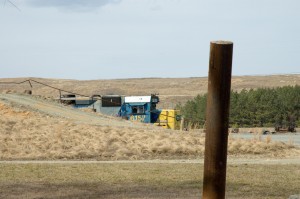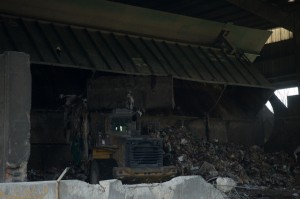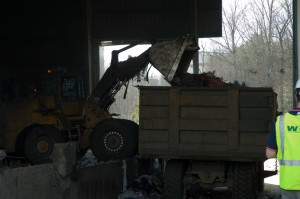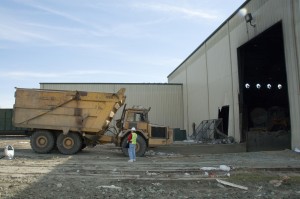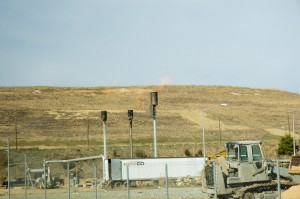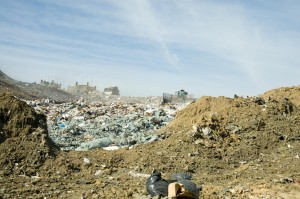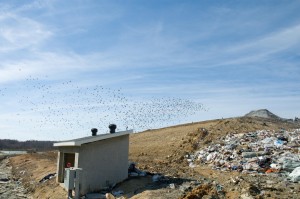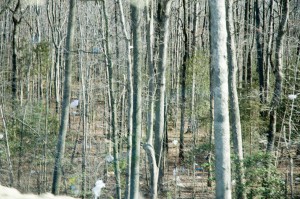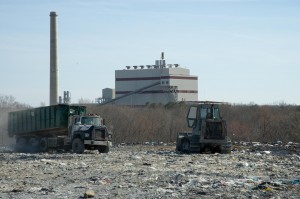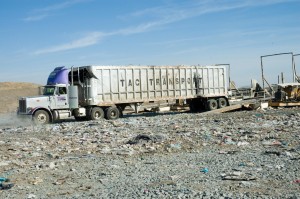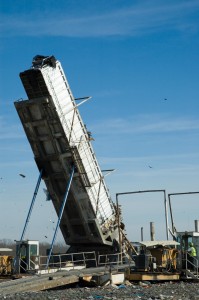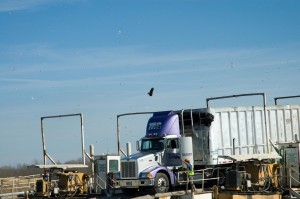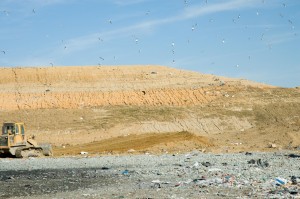http://www.youtube.com/watch?v=GroeqVYSkGk
Appliances: YES
Where: St. Andrews’ Landfill
Why: The County has a contract with the Maryland Environmental Service to purge all air conditioners, freezers and refrigeration units of Class I (CFC’s) and Class II (HCFC’s) ozone depleting substances in accordance with the Federal Clean Air Act and removal of PCB’s from same
How:
For more info, click here:
Antifreeze: YES
Where: Six convenience centers
Why: ?
How: ? (particularily for filters & antifreeze?)
For more info, click here:
The County began its waste oil collection program in June 1989 at the Ridge, Valley Lee, Oakville and Clements Convenience Centers. The Maryland Environmental Service has since provided containers at all the Convenience Centers for the collection of used motor oil and anti-freeze. An annual preferred Recycle Services Agreement with U.S. Filter / Eastern Oil Company ensures the 275 gallon tanks are serviced and kept operational. In 2001 we began recycling used oil filters! Hydraulic fluid, kerosene, diesel fuel, #2 fuel oil and transmission fluid may be mixed with waste oil. Do not mix gasoline, antifreeze, brake fluid, cleaning solvents, refrigerator oil, transformer oil, paint thinners, animal / vegetable oils, ink or water with the waste oil.
Batteries, Auto: ???No
Where: St. Andrew’s Landfill
How: Put in the …. … ???
Why: Either provided to a recycler or included as a part of our Drop N’ Swap program
For more info, click here…
Consider Auto Battery Stores?
Batteries, Rechargeable: YES
Where: Six convenience centers and St. Andrew’s Landfill
How: Put in the …. … ???
Why: Either provided to a recycler or included as a part of our Drop N’ Swap program
For more info, click here…
Each year billions of used batteries are disposed of into solid waste facilities in the United States. Each facility that makes the decision to implement battery recycling programs will help protect the environment and insure their compliance with environmental laws. On July 1, 2001, a formal program, “Operation Recharge”, for battery recycling was established at the County’s six (6) convenience centers and at the St. Andrews Landfill. Rechargeable batteries such as Nickel Cadmuim (Ni-Cd), Nickel Metal Hydride (Ni-Mh), Lithium Ion (Li-ion) and Small Sealed Lead (Pb) are eligible for the “Operation Recharge” program. Once collected, the batteries are bulk shipped to RBRC for recycling credit. To date, the program also includes the collection of lead acid batteries from cars, motorcycles, pick-up trucks, lawn mowers, R/V’s and boats. Once collected, these batteries are either provided to a recycler or included as a part of our Drop N’ Swap program. The batteries accepted may be full, drained, steel or glass cased. How do you start a battery recycling program?
Batteries, Regular: No
Where: ?
How: ?
Why: Can be thrown in with regular trash
For more info, click here…
Each year billions of used batteries are disposed of into solid waste facilities in the United States. Each facility that makes the decision to implement battery recycling programs will help protect the environment and insure their compliance with environmental laws. On July 1, 2001, a formal program, “Operation Recharge”, for battery recycling was established at the County’s six (6) convenience centers and at the St. Andrews Landfill. Rechargeable batteries such as Nickel Cadmuim (Ni-Cd), Nickel Metal Hydride (Ni-Mh), Lithium Ion (Li-ion) and Small Sealed Lead (Pb) are eligible for the “Operation Recharge” program. Once collected, the batteries are bulk shipped to RBRC for recycling credit. To date, the program also includes the collection of lead acid batteries from cars, motorcycles, pick-up trucks, lawn mowers, R/V’s and boats. Once collected, these batteries are either provided to a recycler or included as a part of our Drop N’ Swap program. The batteries accepted may be full, drained, steel or glass cased. How do you start a battery recycling program?
Bicycles: YES
Where: St. Andrew’s Landfill
How: ???
Why: salvaged by staff and made available for restoration or distribution by volunteers and residents to those in need in our community.
For more info, click here
The “Good to Go” Program is planned to be a voluntary partnership being established in an effort to help clean up the environment through prevention, reuse of materials and recycling. This CHALLENGE is designed to give residents, small charitable businesses and not-for profit organizations an opportunity to be leaders in St. Mary’s County. For example, In November 2005, our Bikes for Tykes program was initiated at the St. Andrews Landfill – bicycles destined for disposal are now salvaged by staff and made available for restoration or distribution by volunteers and residents to those in need in our community.
Boats: YES
Where: St. Andrew’s Landfill
How: ???
Why: Landfill at $65/ton or some metal may be recycled
Cans, Aerosol: NO
The system consists of four (4) distinct components: the puncturing unit, a liquid collection drum; a coalescing filter and flexible hose; and a filter indicator. The operator removes the spray nozzle from the can, which is placed upside down into the top of the unit. A puncture pin allows the waste contents to drain into a 55-gallon drum through the filter, a process that takes anywhere from 30 seconds to two minutes. A carbon canister with an indicator shows when the filter needs to be changed (ie. has reached saturation). Each unit can process about 187 waste aerosol paint cans before the operator needs to change the filter. The empty container is then ready to be properly recycled. The EPA’s certification remains valid for three (3) years and is limited to treating aerosol cans containing paints or hydrocarbon lubricants (degreasers) and cleaners, provided the ingredients do not contain chlorinated solvents, freon or other halogenated propellants.
Cans, Aluminum: YES
Where: Six convenience centers
Why: hauled to a processing facility, baled and sent to mills where the material(s) is processed into new containers or a variety of other products.
How: Place in “single stream” recycling container.
For more info, click here:
Cans, Steel: YES
Where: Six convenience centers
Why: hauled to a processing facility, baled and sent to mills where the material(s) is processed into new containers or a variety of other products.
How: Place in “single stream” recycling container.
For more info, click here:
Cans, Tin: YES
Where: Six convenience centers
Why: hauled to a processing facility, baled and sent to mills where the material(s) is processed into new containers or a variety of other products.
How: Place in “single stream” recycling container.
For more info, click here:
Carboard, Corrugated: YES
Where: Six Convenience centers
How: Place in corrugated carboard container, please break down and lay flat
Why: Commerical market recycling
For more info, click here:
Effective March 2, 1998 old corrugated cardboard (OCC) collection was provided at the six convenience centers. Recycling cardboard reduces the volume of waste disposed in the landfill, reduces disposal fees and can generate revenues to help offset the operational costs of the program. Corrugated cardboard is characterized by its “wavy” middle layer. Waxed cardboard and chipboard are not acceptable. Please remove all food, plastic liners, waxed paper and styrofoam from inside the boxes. An average of more than 5,000 tons of cardboard per year is recycled from both residential and commercial sectors each year, with over half from the County convenience centers. Slotted bins have been provided at the convenience centers to help keep the material clean and dry. Reuse your boxes if you can.
On November 14, 2000 the Board of County Commissioners and the Patuxent River Naval Air Station entered into a formal MOU regarding cardboard recycling.
Carboard, Other: ???
Where: Six Convenience centers
How: ??? Place in single stream?
Why: ?
For more info, click here:
Effective March 2, 1998 old corrugated cardboard (OCC) collection was provided at the six convenience centers. Recycling cardboard reduces the volume of waste disposed in the landfill, reduces disposal fees and can generate revenues to help offset the operational costs of the program. Corrugated cardboard is characterized by its “wavy” middle layer. Waxed cardboard and chipboard are not acceptable. Please remove all food, plastic liners, waxed paper and styrofoam from inside the boxes. An average of more than 5,000 tons of cardboard per year is recycled from both residential and commercial sectors each year, with over half from the County convenience centers. Slotted bins have been provided at the convenience centers to help keep the material clean and dry. Reuse your boxes if you can.
On November 14, 2000 the Board of County Commissioners and the Patuxent River Naval Air Station entered into a formal MOU regarding cardboard recycling.
Cell Phones: YES
Where: Six convenience centers
Why: ?
How: ??? Place in the gray storage container labeled “Electronic Recycling”
For more info, click here:
Clothing and Textile: YES
Where: Six Convenience centers
How: Place in labeled container
Why: The materials are then sorted and distributed abroad to support Red Cross disaster relief, homeless shelters, local charities, AIDS prevention /education efforts and community development projects in countries less fortunate than ours
For more info, click here:
The collection of textiles at the convenience centers began in April 1996 thanks to the help of the Melwood Horticultural Training Center. The initiation of this new collection campaign received the 1996 Maryland Recyclers’ Coalition Outstanding Small Government Program Award. As of March 20, 2003, Planet Aid is collecting material at all of our convenience centers. The materials are then sorted and distributed abroad to support Red Cross disaster relief, homeless shelters, local charities, AIDS prevention /education efforts and community development projects in countries less fortunate than ours. Any kind of clean, dry clothing is acceptable. Shoes should be tied or securely fastened together. Stuffed animals and cloth dolls as well as sheets, towels, nylon shower curtains, tablecloths, napkins, hats, gloves, belts, and purses are all acceptable. Wet clothing, rugs, plastic and foam backed drapes are not acceptable. See our Reuse Directory for other drop-off locations. Between 100-150 tons of textiles are being collected from St. Mary’s County residents each year.
Christmas Trees: YES
Where: Six convenience centers and St. Mary’s Watershed Park
How: Drop off trees between 26 Dec and late January
Why: Ground into mulch to be given out to County residents
For more info, click here:
Beginning in December 1993, Christmas trees were accepted at the St. Andrews Landfill and Point Lookout State Park free of charge. In December 1994 the seasonal program was expanded to include drop-off locations at all six (6) County operated convenience centers and the St. Mary’s River Watershed Park. Typical collection dates are between December 26 and the end of January. Each year, trees left at the convenience centers are collected and ground into mulch on-site. Approximately 15 tons of mulch is generated from the processing the Christmas Trees. Donations of mulch have also been made to the Horticulture Program. Trees can also be dropped off at the signed areas near the park entrances and will be used to provide animal habitats. For specific times and dates contact the Point Lookout Park Service at (301) 872-5688 or the County Solid Waste Manager at (301) 863-8400. Please remove all tinsel, garland and ornaments. Help us qualify for the SWANA Christmas Tree Recycling Excellence Award next year.
Computers: YES
Where: Six convenience centers
Why: ?
How: Place in the gray storage container labeled “Electronic Recycling”
For more info, click here:
Cylinder Tanks: YES
Where: St. Andrew’s Landfill
How: ???
Why: Blue Rhino Services will remove the material and the weight will be credited towards the State’s mandated recycling goals.
For more info, click here:
Effective May 17, 2001, the St. Andrews landfill began accepting camping stove propane tanks, oxygen tanks, acetylene bottles, carbon dioxide cylinders and freon tanks from residential and commercial customers. Acceptable container sizes are 10, 20, 30, 40 and 100 pound cylinders. Click Here for additional information on propane safety.
This program allows the citizens of St. Mary’s County to safely and properly dispose of full or partially expended containers free of charge and will help reduce the costs associated with our Household Hazardous Waste Collection Day events. Blue Rhino Services will remove the collected materials from St. Andrews every other Thursday. All weights will be credited toward the State’s mandated recycling goals.
Electronics: YES
Where: Six convenience centers
Why: ?
How: Place in the gray storage container labeled “Electronic Recycling”
For more info, click here:
Flourescent Bulbs: YES
Where: Six convenience centers
Why: The primary purpose of the program is to reduce the amount of mercury entering the environment; the various bulbs and lamps collected each contain measurable amounts of this element. The secondary purpose is to properly dispose of the PCB’s contained in some older ballasts, and to recycle the copper and other materials contained in all ballasts.
How: ?? Place in the gray storage container labeled “Electronic Recycling” bulb box?
For more info, click here:
“The “”Bulb & Ballast Recycling”” Program, was begun in calendar year 2005 and is designed to collect used fluorescent lamps, high intensity discharge (HID) bulbs, neon lamp tubing of all shapes and sizes, ballasts, boxes for lamps and drums for ballasts, then picked up bi-weekly by a certified recycler (Capitol Recycling). There is no additional cost for this service at the convenience centers since the program is part of our Electronics Recycling initiative.The “”Bulb & Ballast Recycling”” Program, was begun in calendar year 2005 and is designed to collect used fluorescent lamps, high intensity discharge (HID) bulbs, neon lamp tubing of all shapes and sizes, ballasts, boxes for lamps and drums for ballasts, then picked up bi-weekly by a certified recycler (Capitol Recycling). There is no additional cost for this service at the convenience centers since the program is part of our Electronics Recycling initiative.The primary purpose of the program is to reduce the amount of mercury entering the environment; the various bulbs and lamps collected each contain measurable amounts of this element. The secondary purpose is to properly dispose of the PCB’s contained in some older ballasts, and to recycle the copper and other materials contained in all ballasts.This program has been implemented at all six (6) of the County’s Convenience Centers, at the Building Services Division for maintenance of all County buildings and facilities, and is also being implemented by the Board of Education. Complete compliance with the law does not allow handlers to throw fluorescent lamps or ballast into a landfill, but required them to assure they are either being recycled or disposed of in a permitted hazardous waste landfill.By recycling the fluorescent lamps and ballasts we are assuring no future liability and that we are in complete compliance with the State of Maryland Laws and Regulations.”
Glass: YES
Where: Six convenience centers
Why: hauled to a processing facility, baled and sent to mills where the material(s) is processed into new containers or a variety of other products. This program has been implemented at all six (6) of the County’s Convenience Centers, at the Building Services Division for maintenance of all County buildings and facilities, and is also being implemented by the Board of Education. Complete compliance with the law does not allow handlers to throw fluorescent lamps or ballast into a landfill, but required them to assure they are either being recycled or disposed of in a permitted hazardous waste landfill.
How: Place in “single stream” recycling container.
For more info, click here: By recycling the fluorescent lamps and ballasts we are assuring no future liability and that we are in complete compliance with the State of Maryland Laws and Regulations.
Ink Jet Cartridges: YES
Where: Six convenience centers
Why: Commerical market recycling
How: Pick up pre-paid mailing bag at convenience centers, drop in mail. For large volume, contact DPW for a collection bin.
For more info, click here:
“IT PAY$ TO RECYCLE”. Don’t throw your used ink jet cartridges away! If the cartridges have not been re-filled, re-manufactured or damaged in shipping, Enviro SMART will pay you $2 for each cartridge. On February 5, 2001, the DPW&T began recycling it’s used printer cartridges for cash. Every time a cartridge is returned, the amount of solid waste being placed into landfills is reduced. In addition, we are minimizing the use of our limited natural resources required to produce new cartridges. We hope to expand the program throughout all of St. Mary’s County Government departments and other public agencies-including the Naval Air Station. Most HP inkjet and laser cartridges are accepted, many of the Canon series cartridges, IBM laser, Lexmark laser and Xerox laser cartridges are also accepted. Choose one of the following simple collection methods that will work best for your organization:
Collection Envelopes can be provided by Enviro SMART. These envelopes are pre-addressed and postage paid. Just place the empty cartridge into it’s original box (or new cartridge packaging), place it in the envelope and drop it in the mail.
Magazines: YES
Where: Six convenience centers
Why: hauled to a processing facility, baled and sent to mills where the material(s) is processed into new containers or a variety of other products.
How: Place in “single stream” recycling container.
For more info, click here:
Today, the U.S. paper industry recovers nearly 50 percent of the paper consumed in the U.S. for recycling. It is estimated that every ton of paper recycled saves more than 3.3 cubic yards of landfill space. An average household recovers about 45 pounds of newspapers, writing papers, magazines, catalogs, packaging and shipping containers annually. The paper industry has set an aggressive goal to recover 55 percent of all paper consumed in the U.S. by 2012. This is an ambitious national goal, and we need your help to get there. Our solid waste consultant, GBB, estimated waste magazines are generated at a rate of between 8.3 and 20.3 pounds per person, per year in St. Mary’s County. The total tons of magazines that could be recovered from residents at an estimated 50% recovery rate are between 158 and 386 tons annually. On October 5, 1993 the County initiated a regional pilot program with the Patuxent Naval Air Station and Calvert County and began collecting magazines at the convenience centers. In January 1996, the Department discontinued this regional effort and provided it’s own dedicated magazine program. In the first year 167 tons of magazines were recycled from the County’s program. Any magazine, catalog, TV Guide, Readers Digest printed on glossy paper is acceptable. Since then, we have added newspaper collection and are collecting over 2,000 tons per year, with over 1,500 tons coming from residents at the County convenience centers.
Metal Scrap: YES
Where: St. Andrews’ Landfill
Why: The County has a contract with the Maryland Environmental Service to purge all air conditioners, freezers and refrigeration units of Class I (CFC’s) and Class II (HCFC’s) ozone depleting substances in accordance with the Federal Clean Air Act and removal of PCB’s from same
How:
For more info, click here:
Newspaper: YES
Where: Six convenience centers
Why: hauled to a processing facility, baled and sent to mills where the material(s) is processed into new containers or a variety of other products.
How: Place in “single stream” recycling container.
For more info, click here:
Today, the U.S. paper industry recovers nearly 50 percent of the paper consumed in the U.S. for recycling. It is estimated that every ton of paper recycled saves more than 3.3 cubic yards of landfill space. An average household recovers about 45 pounds of newspapers, writing papers, magazines, catalogs, packaging and shipping containers annually. The paper industry has set an aggressive goal to recover 55 percent of all paper consumed in the U.S. by 2012. This is an ambitious national goal, and we need your help to get there. Our solid waste consultant, GBB, estimated waste magazines are generated at a rate of between 8.3 and 20.3 pounds per person, per year in St. Mary’s County. The total tons of magazines that could be recovered from residents at an estimated 50% recovery rate are between 158 and 386 tons annually. On October 5, 1993 the County initiated a regional pilot program with the Patuxent Naval Air Station and Calvert County and began collecting magazines at the convenience centers. In January 1996, the Department discontinued this regional effort and provided it’s own dedicated magazine program. In the first year 167 tons of magazines were recycled from the County’s program. Any magazine, catalog, TV Guide, Readers Digest printed on glossy paper is acceptable. Since then, we have added newspaper collection and are collecting over 2,000 tons per year, with over 1,500 tons coming from residents at the County convenience centers.
Oil, Cooking & Kitchen Grease: YES
Where: Six convenience centers
Why: provide the raw materials necessary to produce “Biodiesel”, an alternative fuel to be used in diesel powered equipment
How: Please look for the brown containers labeled “Waste Kitchen Grease Only”.
For more info, click here:
Oil, Motor & Filters: YES
Where: Six convenience centers
Why: ?
How: ? (particularily for filters & antifreeze?)
For more info, click here:
The County began its waste oil collection program in June 1989 at the Ridge, Valley Lee, Oakville and Clements Convenience Centers. The Maryland Environmental Service has since provided containers at all the Convenience Centers for the collection of used motor oil and anti-freeze. An annual preferred Recycle Services Agreement with U.S. Filter / Eastern Oil Company ensures the 275 gallon tanks are serviced and kept operational. In 2001 we began recycling used oil filters! Hydraulic fluid, kerosene, diesel fuel, #2 fuel oil and transmission fluid may be mixed with waste oil. Do not mix gasoline, antifreeze, brake fluid, cleaning solvents, refrigerator oil, transformer oil, paint thinners, animal / vegetable oils, ink or water with the waste oil.
Paper (Mixed): YES
Where: Six convenience centers
Why: hauled to a processing facility, baled and sent to mills where the material(s) is processed into new containers or a variety of other products.
How: Place in “single stream” recycling container.
For more info, click here:
” It is estimated that paper comprises about 40% of the municipal solid waste stream; and if you are in an office, paper makes up 70-80% of the volume of your trash. Beginning August 3, 1999 office workers , small business owners, and citizens were able to bring in a larger variety of paper products for recycling to the six(6) convenience centers at no charge which resulted in the collection of 1400 tons, and in 2003, over 4200 tons of office/mixed paper was recycled in St. Mary’s County, a 327% increase! “”Mixed Paper”” includes computer paper, letterhead, manila folders, ledger paper, both white and mixed colors, envelope cards, file folders, pamphlets, and note pad paper (including the thin card stock backing of note pads). Unfortunately, we cannot accept carbon paper, food wrappers, and containers of packaging soiled by food or restroom waste paper. By recycling you will be helping the County reduce its current cost for waste disposal . On November 14, 2000 the Board of County Commissioners and the Patuxent River Naval Air Station entered into a formal MOU regarding mixed paper recycling. SINGLE STREAM RECYCLING IS NOW AVAILABLE for your convenience. Newspaper, magazines, mixed paper, phone books, plastic and glass containers, tin / steel / aluminum cans may all be “”mixed together”” and no longer need to be sorted.In September 1995, with the help of the Building Services Division and our janitorial and recycling contractors, the Department began a pilot project for the collection of office paper from eighteen (18) County-maintained buildings. This program was made possible because of an improvement in the paper markets. In 1998, County government workers recycled 60.17 tons of office paper , which was 21% more than our 1997 calendar year total of 49.65 tons. If you work in an office that makes a lot of copies, suggest that everyone try to copy on both sides of the paper. This cuts your use of copy paper in half.During the Program’s first year (1996) 23.84 tons of office paper was collected. On April 2000, in conjunction with Earth Day, the County participated in the Annual National Clean Out Your Files Day. The event made it possible for office workers to purge their workplace of a variety of paper products including computer paper, letterhead, white ledger paper, cards and envelopes. This event is held each year nationwide. Due to the success of the program, containers are now provided for the collection of mixed paper, cardboard and co-mingled beverage containers at selected facilities. “
Phone books: YES
Where: Six convenience centers
Why: hauled to a processing facility, baled and sent to mills where the material(s) is processed into new containers or a variety of other products.
How: ??? Or do you want in “Single Stream”
For more info, click here:
The County began this seasonal collection effort in January 1994. The program runs for approximately six (6) months between the months of October and March and coincides with the distribution cycle for new directories. Approximately 15 tons were collected from the residential program each year. During this time phone books are accepted at all six Convenience Centers and at certain central receiving areas in County-maintained buildings.
Pesticide containers: YES
Where: St. Andrews’ Landfill
Why: containers that pass inspection are temporarily stored at the St. Andrew’s Landfill Facility prior to being chipped in October and transported to market.
How: ?? Place in the gray storage container labeled “Electronic Recycling” bulb box?
For more info, click here:
It is estimated that between 25 to 35 million empty pesticide containers are sold annually in the United States. When empty, these containers take up valuable landfill space and if improperly disposed of, can present a threat to water quality. To address this issue, the Maryland Department of Agriculture (MDA) has been conducting annual collection programs since 1993. St. Mary’s County entered into a Cooperative Agreement with the State on June 11, 1996 to offer the Program to the County’s residents. There are three (3) collection dates established each year between the months of June and September.
Plastic containers: YES
Plastics
Pesticide Regulation Section at (410) 841-5710.
Where: Six convenience centers
Why: hauled to a processing facility, baled and sent to mills where the material(s) is processed into new containers or a variety of other products.
How: Place in “single stream” recycling container.
For more info, click here:
The three arrows symbol is not an indication that an item can be recycled. The recycling symbol is unregulated, meaning that no authority controls who places the symbol on what product, be it recyclable or not. The plastics industry uses the recycling symbol as an “in house” coding system to identify resin types as follows:
#1 PETE (polyethylene terephthalate) is a clear, tough plastic. Its ability to hold carbon dioxide (carbonation) makes it great for soft drink usage. Mouthwash bottles, peanut butter jars and some spice and ketchup bottles are also made from PET.
#2 HDPE (high density polyethylene) has excellent protective barrier properties and is used, usually, for milk and water jugs, detergents, bleaches and cleaners.
#3 V (polyvinyl chloride) is used for telephone cable, floor mats, irrigation pipe, truck bed liners, and garbage cans.
#4 LDPE (low density polyethylene) is used to make bottles that require flexibility. To take advantage of its strength and toughness in film form, it is used to produce grocery bags, garbage bags, shrink film and stretch film. It is also used for plastic lumber.
#5 PP (polypropylene) is ideal for the use in caps and lids that have to hold tightly on to threaded openings. It is also used in carpet backing, auto battery cases, video cassette cases, and plastic lumber.
#6 PS (polystyrene) is a colorless plastic that can be clear and hard. It can also be foamed to provide exceptional insulation properties. Foamed or expanded polystyrene (EPS) is used for products such as meat trays, egg cartons and coffee cups. It is also used for packaging and protecting appliances, electronics and other sensitive products. Other uses of PS include silverware, toys, plastic lumber, and garbage cans.
#7 OTHER is used for plastic lumber, parking lot backstops, barrier retainers, fencing, sign posts, pallets, picnic tables, and playground equipment.
For more information on plastic recycling programs click here.
Tires: YES
Where: St. Andrews’ Landfill
Why: St. Mary’s County entered into an Intergovernmental Agreement with the MES to recycle scrap tires. The MES shreds the tires and markets the material to be used as an alternative to wooden mulch, surfac
How: , Typically, residents of St. Mary’s County may drop-off up to five (5) tires at no charge and commercial haulers must pay a tip fee of $158 per ton
For more info, click here:
As of January 1, 1994, with the approval of House Bill 1202, scrap tires are no longer permitted to be disposed of in landfills. Although there is a ban on the disposal, the Department continues to accept tires at the St. Andrews Landfill Facility in accordance with its Secondary Scrap Tire Collection Facility License which allows anywhere from 51 to 1,500 tires to be located on the premises. The current permit, 2003-RSC-00185 was issued on September 17, 2003 and is due for renewal by September 16, 2008.Typically, residents of St. Mary’s County may drop-off up to five (5) tires at no charge and commercial haulers must pay a tip fee of $158 per ton. COMAR 26.04.08.10B(10) requires the Department prepare Semi-annual reports for submission to the State to monitor tire disposal and storage activities. On April 25, 1998 the Maryland Environmental Service assisted the County in the 1st annual Scrap Tire Amnesty Day which was funded (both publicity and disposal) from the State’s Used Tire Cleanup and Recycling Fund (created from the $1.00 fee on the sale of each new tire-reduced in 1999, to $0.50 and subsequently increased to $0.80 in 2005). The fifteen(15) Maryland Counties participating in the event collected a total of 1,642.29 tons of scrap tires which were transported and disposed of by the State at a cost of $241,408.25. St Mary’s County collection efforts at the St. Andrews Landfill Facility yielded 2,085 tires (43.86 tons) with a corresponding disposal cost of $4,853. St. Mary’s County continues to host Tire Amnesty Day events as funding is made available by the State.The 2004 event resulted in the collection of 1,011 tires (32.13 tons) and the 2006 event collected 1,498 tires (69.91 tons). The next Tire Amnesty Day is scheduled for April 26, 2008 at the St. Andrews Landfill. In the interim, residents may recycle up to five (5) tires per trip at the St. Andrews Landfill year-round.
Trailers: NO
Where: St. Andrews’ Landfill
Why: St. Mary’s County entered into an Intergovernmental Agreement with the MES to recycle scrap tires. The MES shreds the tires and markets the material to be used as an alternative to wooden mulch, surfac
How: , Typically, residents of St. Mary’s County may drop-off up to five (5) tires at no charge and commercial haulers must pay a tip fee of $158 per ton
For more info, click here:
The County does accept trailers at the St Andrews landfill if all material is removed from within the unit and the trailer is dismantled and brought in on normal trucks. Any material disposed of in the landfill will be assessed a $65 per ton fee. Any material accepted for metal recycling, or any white goods would be accepted at no charge. Individuals are encouraged to obtain a copy of the County’s Reuse Directory for the disposal of bedding, fabric, fuel tanks, wood, furniture, etc. within the unit that may be otherwise utilized prior to disposal. The County cannot accept any trailers that are in-tact as it would have to rent the necessary personnel and equipment to dismantle the trailer such as a crane, cutting torches, etc. The trailers themselves weigh approximately five (5) tons and at the $65 per ton tipping fee would not offset the costs of disposal. A listing of scrap metal haulers may obtained at the Department of Public Works & Transportation.
Yard Waste: Yes
[-] What: ?
Where: St. Andrews’ Landfill
Why: Mulch is available for pick-up by residents, community and civic groups (elementary schools, technical centers and colleges) at no charge; Although the Department makes reasonable effort to assure that the product is free of foreign material, we make no guarantees and ask residents to sign a disclaimer. The majority of material is used; to mulch around County-maintained buildings, as topsoil for roadside maintenance and repair work, and the construction of nature trails. The Department plans to expand services to include grass and leaves
How: ?
For more info, click here:
ing
A Joint Services Agreement was executed on July 13, 1993 between Calvert and St. Mary’s Counties for the cost-sharing of tub grinding and windrow turning equipment used in the processing of yard waste. The Department also took advantage of an MES grant and received reimbursement for the construction of a paved yard waste composting site at the St. Andrews Landfill. The Agreement represented a regional solution to the planned October 1, 1994 State-wide ban on source separated yard wastes from land-filling. In August 1996, with the initiation of a State-wide mobile tub grinder services contract offered to participating Counties by the Maryland Environmental Service, the Joint Services Agreement was terminated.
The Department currently grinds the collected material at a cost of about $10 per ton and stockpiles it on-site for future use. In 1997, almost 216 tons of mulch was produced – the Program effort resulted in an increase to 533.8 tons in 1999 and in 2003, over 1400 tons was generated!. On November 14, 2000 the Board of County Commissioners and the Patuxent River Naval Air Station entered into a formal MOU regarding wood waste recycling. The MOU allows the Naval Air Station the ability to dispose of their yard waste and purchase mulch for landscaping around the installation.
U-LOAD-U-HAUL! Mulch is available for pick-up by residents, community and civic groups (elementary schools, technical centers and colleges) at no charge; Although the Department makes reasonable effort to assure that the product is free of foreign material, we make no guarantees and ask residents to sign a disclaimer. The majority of material is used; to mulch around County-maintained buildings, as topsoil for roadside maintenance and repair work, and the construction of nature trails. The Department plans to expand services to include grass and leaves

